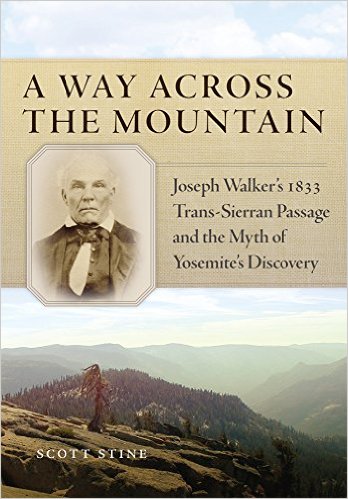
 The Mono Lake Committee is delighted to host Dr. Scott Stine discussing his newly released book: A Way Across the Mountain: Joseph Walker’s 1833 Trans-Sierran Passage and the Myth of Yosemite’s Discovery.
The Mono Lake Committee is delighted to host Dr. Scott Stine discussing his newly released book: A Way Across the Mountain: Joseph Walker’s 1833 Trans-Sierran Passage and the Myth of Yosemite’s Discovery.
• Saturday, October 17, 4:30–6:30pm
• At the Mono Inn, 5 miles north of the town of Lee Vining on Highway 395
• Presentation begins at 4:30pm
If you are a Yosemite-phile like me, you have doubtless heard the legend of the first non-native person to see Yosemite Valley. We’ve all heard the legend of Joseph R. Walker who led a brigade of 58 fur trappers from the Rocky Mountains of Wyoming to the Pacific coast of central California in 1833. Toward the end of their journey the Walker brigade crossed the Sierra Nevada.
Following Walker’s death in 1876, an alluring tale arose concerning his trans-Sierran route. In the course of the crossing, goes the story, Walker found himself on the northern rim of Yosemite Valley at the plungepoint of North America’s tallest waterfall, staring into the most awesome mountain chasm on the continent. Over the decades since then, this time-honored tale has hardened to folklore. Dozens of historical works have construed it as a towering moment in the opening of the West.
In A Way Across the Mountain, Stine reconstructs Walker’s 1833 route over the Sierra, drawing on his intimate knowledge of the geomorphology, hydrography, biogeography and climate of the Sierra Nevada and Great Basin, and employing the detailed travel narrative of the brigade’s field clerk, Zenas Leonard. Stine documents the inception, growth, and persistence of the Yosemite myth and explores the extent to which that lore has overshadowed Walker’s greatest discovery—that the huge swath of continent between the Wasatch Front and the Sierra crest is hydrographically closed, draining not to an ocean, but to salty lakes and desert sands.
Stine has studied Mono Lake and has been involved in the Mono Lake story for many years. He was an expert witness for the California State Attorney General’s Office in the Mono Lake cases. His ongoing work in the Mono Basin focuses on lake level fluctuations of the past 20,000 years, the history and processes of tufa formation, the history and dynamics of deltaic sedimentation, and the volcanic history of the Mono islands, as well as on new and continuing environmental problems.
The setting at the Mono Inn provides a breathtaking vista over the Mono Basin. Fall colors are tinging the basin with gold. The days are warm, the nights becoming chilly. This promises to be a spectacular evening of history, myth, and beauty. You might even consider making a reservation at the Mono Inn (open until 9:00pm) for dinner following the event. I look forward to seeing you there!
This event is free and open to the public. Books are currently available online, or you can purchase one at the event. Proceeds benefit the Mono Lake Committee, and you can always call us for more information at (760) 647-6595.
